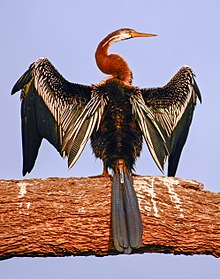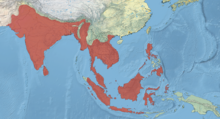Oriental darter
| Oriental darter | |
|---|---|
 |
|
| Scientific classification | |
| Kingdom: | Animalia |
| Phylum: | Chordata |
| Class: | Aves |
| Order: | Suliformes |
| Family: | Anhingidae |
| Genus: | Anhinga |
| Species: | A. melanogaster |
| Binomial name | |
|
Anhinga melanogaster (Pennant, 1769) |
|
 |
|
| Distribution map | |
| Synonyms | |
|
Plotus melanogaster |
|
| Measurements | |||
|---|---|---|---|
| India | |||
| Culmen | 74–90 mm (2.9–3.5 in) | ||
| Wing | 331–357 mm (13.0–14.1 in) | ||
| Tail | 202–240 mm (8.0–9.4 in) | ||
| Tarsus | 42–47 mm (1.7–1.9 in) | ||
| Weight | 1,160–1,500 g (40.9–52.9 oz) | ||
Plotus melanogaster
The Oriental darter or Indian darter (Anhinga melanogaster) is a water bird of tropical South Asia and Southeast Asia. It has a long and slender neck with a straight, pointed bill and, like the cormorant, it hunts for fish while its body submerged is in water. It spears a fish underwater, bringing it above the surface, tossing and juggling it before swallowing the fish head first. The body remains submerged as it swims, and the slender neck alone is visible above the water, which accounts for the colloquial name of snakebird. Like the cormorants, it has wettable feathers and it is often found perched on a rock or branch with its wings held open to dry.
The Oriental darter is like all other anhingas, a cormorant-like species that has a very long neck. The structure of the neck is as in other species of darter with strongly developed muscles about a kink in the neck at the 8th and 9th vertebrae that allows it to be flexed and darted forward with rapid force to stab fish underwater. The edges of the commissures of the mandible tips have minute inward pointing serrations that hold impaled fish.
The adult plumage above is black and the wing coverts and tertials having silvery streaks along the shaft. The crown and neck are brown shading to black towards the back of the neck. The underparts are blackish brown. A pale line over the eye and throat and a line running along the sides of the neck gives it a striped appearance. The iris is white with a yellow ring (brighter yellow in breeding birds) around it. The tip of the upper mandible is dark while the base is pale brown bill while the lower mandible is yellowish. The legs and webbing on the foot are yellow in immatures and non-breeding birds while breeding birds have darker grey tarsi and toes with yellow webbing. The sexes are not easily distinguishable but males tend to have black speckles that coalesce on the white throat. Adult females have a shorter bill and tend to have the black at the base of neck and chest separated from the hind neck by a wide buff band that ends at the shoulder. This pattern however is also found in immatures whose neck is lighter and lack the long pointed scapulars. In flight the long and slender neck, wide wing and wedge shaped tail make it distinctive. Young birds have a pale brown neck and appear whitish on the underside and lack the white streak along the side of the neck. The inner secondaries or tertials and the central tail feathers appear wavy or corrugated. The tail is long and made up of twelve stiff feathers which are dragged along the ground when the bird attempts to walk or hop on land.
...
Wikipedia

